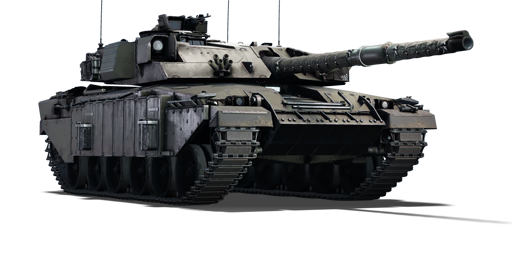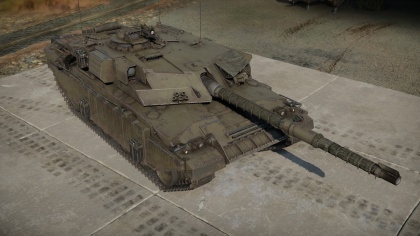Challenger Mk.3
Contents
| This page is about the British medium tank Challenger Mk.3. For other uses, see Challenger (Disambiguation). |
Description
The Tank, Combat, 120-mm Gun, Challenger Mk.3 (shortened as Challenger Mk.3) is a Rank British medium tank with a battle rating of (AB), (RB), and (SB). It was introduced in Update 1.85 "Supersonic".
The Challenger Mk.3 retains most of the characteristics of the Challenger Mk.2. It has some unique differences; such as: "ROMOR-A ERA" which covers the lower glaciers and sides, along with the addition of the ammunition storage being covered with rolled homogeneous armour. It retains the same engine (1200hp) as the Mk.2, however with a minor increase in weight it suffers slightly reduced mobility and acceleration. Its iconic, legendary, and pin-point accurate gun stays the same as on the Challenger Mk.2.
General info
Survivability and armour
The armour protection on the Challenger Mk.3 is excellent in some areas and bad in others. The upper half of the turret cheeks are capable of withstanding all kinetic penetrators except the Ariete top round and will stop most chemical penetrators with less than 800 mm, while the lower half won't protect against most top-tier rounds. Additionally, the breach weak spot is quite small. This means the turret has excellent protection and hulldown play is recommended. The hull composite is only good against lower penetrating APFSDS rounds such as T-55AM, and can also withstand some chemical munitions, but it is not advised to rely on this armour. The rest of the tank (turret and hull sides, lower front plate) has decent protection against chemical rounds due to the add on armour, ERA, and thick turret sides.
Mobility
The Challenger Mk.3 has an acceptable top speed, however acceleration and mobility (primarily due to its weight) are lacklustre compared to other MBTs.
| Weight (tons) | Add-on Armour weight (tons) |
Max speed (km/h) |
|---|---|---|
| 65.5 | N/A | 39 (AB) |
| 35 (RB/SB) | ||
| Engine power (horsepower) | ||
| Mode | Stock | Upgraded |
| Arcade | 1,860 | 2,290 |
| Realistic/Simulator | 1,061 | 1,200 |
| Power-to-weight ratio (hp/ton) | ||
| Mode | Stock | Upgraded |
| Arcade | __.__ | __.__ |
| Realistic/Simulator | __.__ | __.__ |
| Module rotation speed | 90 Degrees | 180 Degrees | 360 Degrees |
|---|---|---|---|
| Tank Hull | 5 Seconds | 10 Seconds | 20 Seconds |
| Tank Turret | 3 Seconds | 6 Seconds | 12 Seconds |
| Test Conditions | *Tank and crew conditions of this test were done using a spaded Challenger MK 3: With crew at maximum crew skill, with the qualification of basic training. Results can vary based on tank research state, crew levels & qualifications. | ||
Armaments
Main armament
The Challenger's main gun, while not the most powerful at 9.7, is competitive, and more importantly, accurate. With a little over 400mm of penetration at maximum, aim for weak spots (particularly when facing 10.0 vehicles such as the T-80U, Leopard 2A5, etc) and make use of the Challenger's good reload speed.
Additional armament
Some tanks are armed with several guns in one or more turrets. Evaluate the additional weaponry and give advice on its use. Describe the ammunition available for additional weaponry. Give advice on how to use them and how to fill the ammunition storage. If there is no additional weaponry remove this subsection.
Machine guns
It is possible to switch to the machine-gun as the main weapon and use thermals through the machinegun sight to get a better view of the situation while hulldown.
Usage in the battles
Urban Environments
In urban environments, the Challenger will struggle relative to the T-80B, M1 Abrams and Leopard 2A4 - it's large, heavy and sluggish which proves costly in close quarters or when engagements occur in open streets. While the Challenger's gun still proves effective, often opposition vehicles will achieve valuable positioning before a Challenger can, forcing the Challenger tanker to play defensively. However, playing carefully and avoiding obvious routes, the Challenger can be comfortably put to use in urban environments.
Rural Environments
The Mk.3 performs very well in rural areas, where deffolades and ditches that can be used for cover are far more readily available. The Challenger is still best played in hull-down defensive positions, clearing areas of maps before moving up, but a patient playstyle will be rewarded. Make use of the vehicle's good gun depression and competitive reload, utilising off-angles and hull-down positions. If a situation begins to degrade, make use of the Challenger's reasonably good reverse speed and reposition.
Pros and cons
Pros:
- Decent turret armour.
- Reasonably small breech.
- Good chemical resistance on front/sides.
- Good neutral steering.
- Decent reverse speed.
- Reasonably good reload, particularly for a 120mm.
Cons:
- Gun has lacklustre penetration values; must aim for weakspots.
- The lower half of the turret cheeks are vulnerable to some higher-tier rounds.
- Slower than most of the vehicles it faces, albeit not by a huge margin.
- Hull is very vulnerable to kinetic rounds.
- Cannot shoot straight over its engine deck.
History
Describe the history of the creation and combat usage of the ground vehicle in more detail than in the introduction. If the historical reference turns out to be too big, take it to a separate article, taking a link to an article about the vehicle and adding a block "/ History" (example: https://wiki.warthunder.com/(Vehicle-name)/History) and add a link to it here using the main template. Be sure to reference text and sources by using <ref>, as well as adding them at the end of the article.
Media
An excellent addition to the article will be video guides, as well as screenshots from the game and photos.
See also
Links to the articles on the War Thunder Wiki that you think will be useful for the reader, for example:
- reference to the series of the vehicles;
- links to approximate analogues of other nations and research trees.
External links
| Britain medium tanks | |
|---|---|
| Valentine | Valentine I · Valentine IX · Valentine XI |
| Cromwell | Cromwell I · Cromwell V · Cromwell V (RP-3) |
| Cromwell derivatives | Challenger · Avenger · Comet I · Comet I "Iron Duke IV" · Charioteer Mk VII |
| Centurion | Centurion Mk 1 · Centurion Mk.2 · Centurion Mk 3 · Centurion Mk.5 AVRE · Centurion Mk 10 · Centurion Action X · FV4202 |
| Vickers MBT | Vickers Mk.1 · Vickers Mk.3 · Vickers Mk.7 |
| Chieftain | Chieftain Mk 3 · Chieftain Mk 5 · Chieftain Mk 10 |
| Challenger 1 | Challenger Mk.2 · Challenger Mk.3 · Challenger DS |
| Challenger 2 | Challenger 2 · Challenger 2 (2F) · Challenger 2 TES · Challenger 2 OES · Challenger 2E · Challenger 2 Black Night |
| Challenger 3 | Challenger 3 TD |
| Australia | A.C.I · A.C.IV · Centurion Mk.5/1 |
| South Africa | Olifant Mk.1A · Olifant Mk.2 · TTD |
| India | Vijayanta · Bhishma TWMP |
| Israel | ▄Sho't Kal Dalet |
| Jordan | Khalid |
| Sweden | ▄Strv 81 (RB 52) |
| USA | Grant I · Sherman II · Sherman Firefly · Sherman IC "Trzyniec" |





